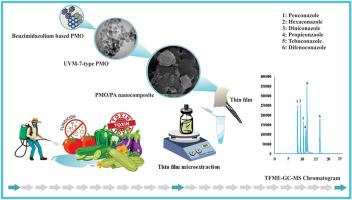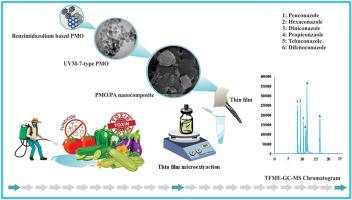Bimodal UVM-7-based periodic mesoporous organosilica containing benzimidazole for thin film microextraction of triazole fungicides in fruiting vegetables prior to gas chromatography-mass spectrometry
IF 5.7
2区 化学
Q1 CHEMISTRY, ANALYTICAL
引用次数: 0
Abstract
Background
Periodic mesoporous organosilicas (PMOs) are a new class of organic-inorganic hybrid materials with high surface area, narrow pore size distribution, high functional group loading, and tunable functional groups. In contrast to other porous organosilicate materials, PMOs show a uniform distribution of organic groups inside their framework walls. They are synthesized by condensing bis-silylated organic precursors around a surfactant template. Their application severely depends on textural features like pore structure, particle size, porosity and surface area. This study focuses on the application of PMOs in trace determination of pesticides, while the structural features of these interesting materials are strongly considered.
Results
Different PMOs with UVM-7 and SBA-15 type mesostructures were synthesized using benzimidazolium salt as the organic modifier. Then the prepared PMOs were employed in thin film microextraction (TFME) composed from Nylon-6 substrate prior to gas chromatography-mass spectrometry (GC-MS) analysis. Afterward, a simple method was adapted for detecting trace amounts of six triazole fungicides in extracts of five commonly consumed fruiting vegetables. The prepared bridged benzimidazolium salt organosilica-based sorbents underwent extensive characterization by FTIR, TEM, SEM, EDX, BET and XRD investigations. After obtaining the extraction results for both PMOs, the best one was implemented as the extractive phase in the further experiments. After optimization, limits of detection and quantification ranged from 0.02 to 0.2 and 0.06–0.7 μg L−1, respectively. The linearity of calibration plots varies at the range of 0.1–500 μg L−1 (R2 = 0.996). Relative standard deviations (RSDs) were found to be 3.9–14.1 %. The relative recoveries (85–115 %) show that this approach works appropriately to detect triazole fungicides in real matrixes.
Significance
PMOs framework upon similar structures with azole fungicides provide interaction between sorbent and the desired analytes. For the first time, the superior PMO nanoparticles with high surface area and accessible bimodal pore systems (UVM-7) were evaluated in thin film microextraction of triazole fungicides from 10-fold diluted fruiting vegetable samples. This study proves PMO structure can be engineered by controlling the synthesis condition depending on application requirements. This finding opens a new horizon in preparing structurally specified sorbents for microextraction purposes.


基于苯并咪唑的双峰周期性介孔有机硅用于气相色谱-质谱分析前果菜中三唑类杀菌剂的薄膜微萃取
背景周期介孔有机硅(PMOs)是一类新型的有机-无机杂化材料,具有高比表面积、窄孔径分布、高官能团负载和可调官能团等特点。与其他多孔有机硅材料相比,PMOs 的框架壁内有机基团分布均匀。它们是通过在表面活性剂模板周围冷凝双硅烷化有机前体而合成的。它们的应用严重依赖于孔结构、粒度、孔隙率和表面积等质地特征。本研究侧重于 PMOs 在农药痕量测定中的应用,同时着重考虑了这些有趣材料的结构特征。结果以苯并咪唑盐为有机改性剂,合成了具有 UVM-7 和 SBA-15 型介质结构的不同 PMOs。然后,在气相色谱-质谱(GC-MS)分析之前,将所制备的 PMOs 用于尼龙-6 底物的薄膜微萃取(TFME)。随后,采用一种简单的方法检测了五种常见果菜提取物中六种三唑类杀菌剂的痕量含量。所制备的桥接苯并咪唑盐有机硅吸附剂通过傅立叶变换红外光谱、TEM、扫描电镜、EDX、BET 和 XRD 研究进行了广泛的表征。在获得两种 PMO 的萃取结果后,在进一步的实验中采用了最好的一种作为萃取相。经过优化后,检出限和定量限分别为 0.02-0.2 和 0.06-0.7 μg L-1。校准图的线性范围为 0.1-500 μg L-1 (R2 = 0.996)。相对标准偏差(RSD)为 3.9%-14.1%。相对回收率(85%-115%)表明,这种方法可用于检测实际基质中的三唑类杀菌剂。在从 10 倍稀释的果菜样品中对三唑类杀菌剂进行薄膜微萃取时,首次对具有高比表面积和可进入双峰孔系的优质 PMO 纳米粒子(UVM-7)进行了评估。这项研究证明,可以根据应用要求控制合成条件来设计 PMO 结构。这一发现为制备结构特定的微萃取吸附剂开辟了新天地。
本文章由计算机程序翻译,如有差异,请以英文原文为准。
求助全文
约1分钟内获得全文
求助全文
来源期刊

Analytica Chimica Acta
化学-分析化学
CiteScore
10.40
自引率
6.50%
发文量
1081
审稿时长
38 days
期刊介绍:
Analytica Chimica Acta has an open access mirror journal Analytica Chimica Acta: X, sharing the same aims and scope, editorial team, submission system and rigorous peer review.
Analytica Chimica Acta provides a forum for the rapid publication of original research, and critical, comprehensive reviews dealing with all aspects of fundamental and applied modern analytical chemistry. The journal welcomes the submission of research papers which report studies concerning the development of new and significant analytical methodologies. In determining the suitability of submitted articles for publication, particular scrutiny will be placed on the degree of novelty and impact of the research and the extent to which it adds to the existing body of knowledge in analytical chemistry.
 求助内容:
求助内容: 应助结果提醒方式:
应助结果提醒方式:


